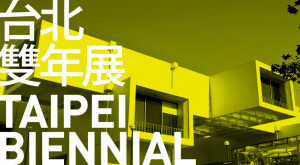Taipei Biennial 2014
The Great Acceleration
September 13, 2014–January 4, 2015
Opening: September 12
Taipei Fine Arts Museum
No. 181 Zhongshan N. Road Sec. 3
Taipei 10461
Taiwan
T +886 2 2595 7656
F +886 2 2585 1886
info@taipeibiennial.org
Curator: Nicolas Bourriaud
51 artists and collectives will appear on the scene:
Harold Ancart (Belgium); Charles Avery (UK); Gilles Barbier (France); Alisa Baremboym (USA); Neil Beloufa (Algeria and France); Peter Buggenhout (Belgium); Roberto Cabot (Brazil); En-Man Chang (Taiwan); Ian Cheng (USA); Ching-Hui Chou (Taiwan); Chun-Teng Chu (Taiwan); Shezad Dawood (UK); David Douard (France); Camille Henrot (France); Roger Hiorns (UK); Xiao-Yuan Hu (China); Po-Chih Huang (Taiwan); Joan Jonas (USA); Hudinilson Júnior (Brazil); Tetsumi Kudo (Japan); Surasi Kusolwong (Thailand); An-My Lê (Vietnam and USA); Kuo-Wei Lin (Taiwan); Maria Loboda (Poland); Jonah Freeman & Justin Lowe (USA); Jr-Shih Luo (Taiwan); Tala Madani (Iran and USA); Abu-Bakarr Mansaray (Sierra Leone and Netherlands); Josephine Meckseper (Germany and USA); Nathaniel Mellors (UK); Marlie Mul (Netherlands); Henrik Olesen (Denmark) OPAVIVARA! (Brazil); Ola Pehrson (Sweden); Hung-Chih Peng (Taiwan); Laure Prouvost (France and UK); Matheus Rocha Pitta (Brazil); Rachel Rose (USA); Pamela Rosenkranz (Switzerland); Mika Rottenberg (Argentina); Sterling Ruby (USA); Timur Si-Qin (Germany); Shimabuku (Japan); Peter Stämpfli (Switzerland); Nicolás Uriburu (Argentina); Patrick Van Caeckenbergh (Belgium); Chien-Ying Wu (Taiwan); Chuan-Lun Wu (Taiwan); Yu-Chen Wang (Taiwan); Haegue Yang (Korea); Anicka Yi (Korea); and other selected works in the Anthropocene room.
The list covers different nationalities from Africa, Asia, Europe, South America, and USA. Taipei Biennial 2014 tends to take a wider, more overall view of the curatorial concept for the biennial around the topic Art and Its New Ecosystem: A Global Set of Relations.
The extent and the acceleration of the industrialization process on the planet have led some scientists to hypothesize a new geophysical era, the Anthropocene. The emergence of this new era, after ten thousand years of the Holocene, refers to the effect of human activities on the earth’s biosphere: global warming, deforestation, soil pollution.
But the concept of the Anthropocene also points to a paradox: the more powerful the collective impact of the species is, the less contemporary individuals feel capable of influencing their surrounding reality. The collapse of the “human scale”: helpless in the face of a computerized economic system whose decisions are derived from algorithms capable of performing operations at the speed of light, human beings have become both spectators and victims of their own infrastructure. Thus, we are witnessing the emergence of an unprecedented political coalition between the individual/citizen and a new subordinate class: animals, plants, minerals and the atmosphere, all attacked by a techno-industrial system now clearly detached from civil society.
Since the 1990s, art has highlighted the social sphere and held inter-human relations, whether individual or social, friendly or antagonistic, to be the main domain of reference. The French philosopher Quentin Meillassoux raises a fundamental question: how can one grasp the meaning of a statement on data prior to any human form of relationship to the world, prior to the existence of any subject/object relationship? In short, how can one think about something that exists completely outside of human thought? Human consciousness is actually a universal measure. In this context, we can compare it to currency, which Marx defined as an “abstract general equivalent” used in the economy.
Art also plays host to an entanglement between the human and nonhuman, a presentation of coactivity as such: Multiple energies are at work, and logical organic growth machines are everywhere. All relations between different regimes of the living and the inert are alive with tension. Contemporary art is a gateway between the human and the nonhuman, where the binary opposition between subject and object dissolves in multiplicitous images: the reified speaking, the living petrified, illusions of life, illusions of the inert, biological maps redistributing constantly.
The Great Acceleration is presented as a tribute to this coactivity, the assumed parallelism between the different kingdoms and their negotiations. This exhibition is organized around the cohabitation of human consciousness with swarming animals, data processing, the rapid growth of plants and the slow movements of matter. So we find ancestrality (the world before human consciousness) and its landscape of minerals, alongside vegetable transplants or couplings between humans, machines and beasts. At the center is this reality: human beings are only one element among others in a wide-area network, which is why we need to rethink our relational universe to include new partners.
In the light, a new generation of artists is exploring the intrinsic properties of materials “informed” by human activity, including polymers (Roger Hiorns, Marlie Mul, Sterling Ruby, Alisa Barenboym, Neil Beloufa, Pamela Rosenkranz) or the critical states of materials (the nebulizations of Peter Buggenhout, Harold Ancart or Hiorns). But polymerization has become a principle of composition, with the invention of flexible and artificial alloys of heterogeneous elements—as can be seen in the videos of Laure Prouvost, Ian Cheng, Rachel Rose or Camille Henrot, the installations of Mika Rottenberg, Nathaniel Mellors or Charles Avery, the paintings of Roberto Cabot or Tala Madani. Others explore weight, transposing the lightness of pixels onto monumental objects (David Douard, Neil Beloufa, Matheus Rocha Pitta…).


